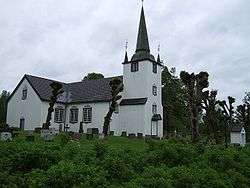Austre Moland
Austre Moland (historic: Østre Moland) is a former municipality in Aust-Agder county, Norway. The municipality existed from 1838 until 1962 when it was merged into the neighboring municipality of Arendal. The administrative centre was at Brekka where the Austre Moland Church is located.[1]
Austre Moland kommune Østre Moland herred | |
|---|---|
 View of the church in Austre Moland | |
 Austre Moland Location of the municipality  Austre Moland Austre Moland (Norway) | |
| Coordinates: 58°32′37″N 08°48′42″E | |
| Country | Norway |
| Region | Southern Norway |
| County | Aust-Agder |
| District | Østre Agder |
| Municipality ID | NO-0918 |
| Adm. Center | Brekka |
| Time zone | UTC+01:00 (CET) |
| • Summer (DST) | UTC+02:00 (CEST) |
| Created as | Formannskapsdistrikt in 1838 |
| Merged into | Moland in 1962 |
History
The parish of Østre Moland was established as a municipality on 1 January 1838 (see formannskapsdistrikt). According to the 1835 census the municipality had a population of 4,513.[2] On 1 January 1875, a small part of the town of Arendal (population: 22) was transferred to Østre Moland.
On 1 May 1878, Østre Moland was divided. The western portion became the municipality of Barbu (population: 4,874) and the southern part on the island of Tromøya became the municipality of Tromøy (population: 2,320). The remainder of Østre Moland was left with 2,524 inhabitants. On 1 July 1919 several things changed. The southern coastal district of Stokken (population: 1,683) was separated from Østre Moland to become a separate municipality, a small area in neighboring Holt municipality (population: 14) was transferred to Østre Moland, and finally, the spelling of the name was changed to Austre Moland. After all of these changes, there were 1,289 residents left in Austre Moland. In 1936, a small area of Øyestad municipality (population: 33) was transferred to Austre Moland. In 1944, a small area of Austre Moland (population: 44) was transferred to the town of Arendal.
During the 1960s, there were many municipal mergers across Norway due to the work of the Schei Committee. On 1 January 1962, Austre Moland (population: 1,607) was merged with the municipalities of Stokken (population: 2,783), Flosta (population: 1,205), and the Strengereid area of Tvedestrand (population: 375) to form the new municipality of Moland. Later, on 1 January 1992, Moland (population: 8,148) was merged into the neighboring municipality of Arendal (population: 12,478). Øyestad, Tromøy, and Hisøy were also merged into Arendal at the same time.[3]
Name
The name comes from Old Norse word Móðguland which is derived from the river name Móðga, which can be linked with the Old Norse word móðigr which means "brave". Austre and the older Østre both means "eastern" in order to differentiate this location from the nearby Vestre Moland in another part of the county.[4]
References
- Thorsnæs, Geir, ed. (2009-02-14). "Austre Moland". Store norske leksikon (in Norwegian). Kunnskapsforlaget. Retrieved 2017-11-27.
- Registreringssentral for historiske data. "Hjemmehørende folkemengde Aust-Agder 1801-1960" (in Norwegian). University of Tromsø.
- Jukvam, Dag (1999). "Historisk oversikt over endringer i kommune- og fylkesinndelingen" (PDF) (in Norwegian). Statistisk sentralbyrå.
- Rygh, Oluf (1905). Norske gaardnavne: Nedenes amt (in Norwegian) (8 ed.). Kristiania, Norge: W. C. Fabritius & sønners bogtrikkeri. p. 87.
External links

- Population Statistics from Statistics Norway